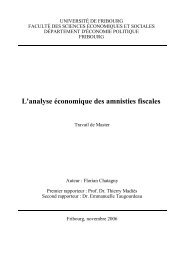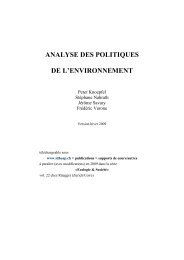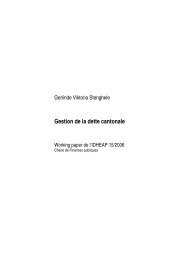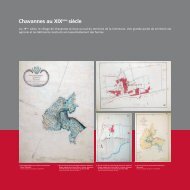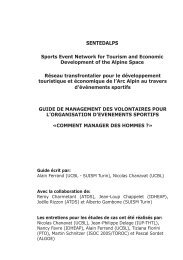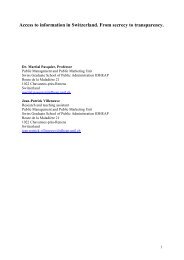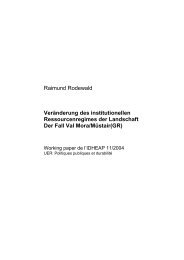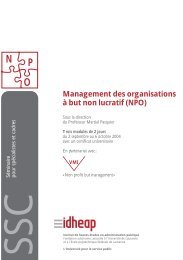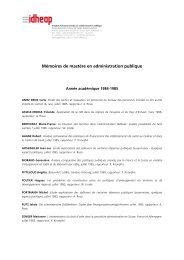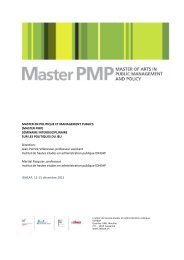Voting advice applications and party choice: evidence from ...
Voting advice applications and party choice: evidence from ...
Voting advice applications and party choice: evidence from ...
Create successful ePaper yourself
Turn your PDF publications into a flip-book with our unique Google optimized e-Paper software.
372 A. Ladner, J. Fivaz <strong>and</strong> J. Pianzola<br />
their answers <strong>and</strong> results <strong>and</strong> to receive additional services. In 2007, a total of 80,225<br />
users owned such accounts. A few days after the elections, all smartvote users with a user<br />
account received an e-mail <strong>and</strong> were asked to support the NCCR research project <strong>and</strong> to<br />
participate in this second survey, <strong>and</strong> 13,959 of them did so.<br />
Data <strong>from</strong> both surveys could be merged into one combined dataset comprising<br />
18,290 respondents in total. Although the data contains a large number of respondents,<br />
we cannot claim that it is representative with regard to the entire population of smartvote<br />
users. That the data stems <strong>from</strong> a self-selected group of smartvote users has to be kept in<br />
mind with regard to the empirical analysis.<br />
To determine the validity of our data, we cross-checked the socio-demographic<br />
profile of smartvote users with the findings of several previous studies. First, we checked<br />
our socio-demographic profile of smartvote users with the profile of a previous study<br />
conducted by Fivaz <strong>and</strong> Nadig (2010). Instead of the NCCR survey data, they used data<br />
<strong>from</strong> the Swiss electoral study (Selects), a representative telephone-based survey. We<br />
found a very similar pattern in both profiles of smartvote users. Furthermore, we also<br />
compared our profile with those of VAA users in other countries (Marchall, 2005;<br />
Marschall <strong>and</strong> Schmidt, 2010; Wall et al., 2009) <strong>and</strong> again found similar patterns. In our<br />
own data as well as in all available studies, the typical VAA user is male, young, <strong>and</strong><br />
well-educated. He also has a high interest in politics <strong>and</strong> exhibits above-average political<br />
activity.<br />
Therefore, we can assume that this dataset is of sufficient quality for the results to be<br />
comparable to those of VAA research <strong>from</strong> other countries. Our aim is not to draw any<br />
general conclusions with regard to the overall impact of smartvote on the elections but,<br />
rather, to remain in the realm of how the tool affected those who actually used it <strong>and</strong><br />
answered our surveys.<br />
4 First analyses: direct impact measurement<br />
The post-electoral surveys conducted among smartvote users contained a number of<br />
questions aimed directly at measuring the potential impact of smartvote. Survey<br />
participants were asked whether the use of smartvote had a direct influence on their<br />
voting decisions or not <strong>and</strong>, if so, how exactly smartvote affected their decisions.<br />
Asked directly, 67% of the respondents stated that smartvote had affected their voting<br />
decisions. These findings differ to a large extent <strong>from</strong> results of similar studies for<br />
Germany, the Netherl<strong>and</strong>s, <strong>and</strong> Belgium. According to Marschall (2005), in Germany,<br />
only 6% of voters using a VAA were directly affected in their electoral decision, <strong>and</strong> in<br />
Belgium, VAAs had an impact only on a small percentage of their users (Walgrave et al.,<br />
2008). Research results for the Netherl<strong>and</strong>s show higher values (Aarts <strong>and</strong> van der Kolk,<br />
2007), but at 15%, there is still a significant difference <strong>from</strong> the 67% we found for<br />
Switzerl<strong>and</strong>. We will return to this aspect later.<br />
In the following tables, we present descriptive statistics about the influence of<br />
smartvote on different user groups. Table 1 shows the share of influenced users with<br />
regard to age, gender, <strong>and</strong> educational level.<br />
Table 1 shows that there are only minor differences between voters with regard to<br />
educational level or gender. The largest differences by far can be found between the<br />
several age groups. The influence of smartvote on voting decisions is strongest among<br />
young voters.



